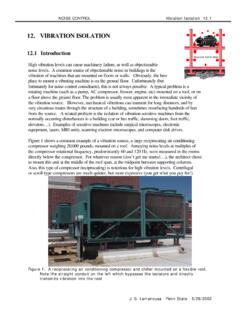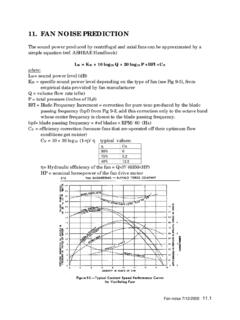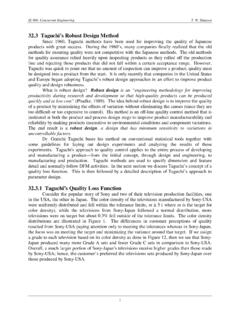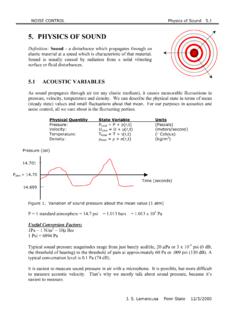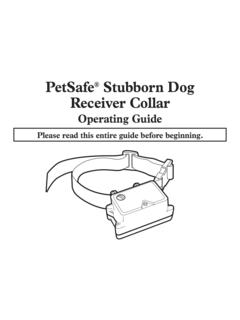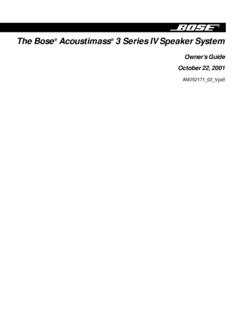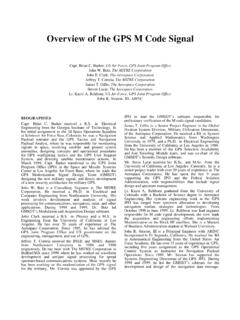Transcription of 9. TRANSMISSION OF SOUND THROUGH STRUCTURES
1 NOISE CONTROL TRANSMISSION J. S. Lamancusa Penn State 12/1/2000 9. TRANSMISSION OF SOUND THROUGH STRUCTURES Basic Definitions A typical noise control application involves a combination of absorption of SOUND and TRANSMISSION of SOUND energy by a variety of airborne and stucture-borne paths. Figure 1. SOUND TRANSMISSION paths between a room containing a noise source and adjacent rooms Some important definitions and concepts: TRANSMISSION Coefficient , for walls IncidentdTransmitteII= ( is a frequency-dependent physical property of the material) SOUND TRANSMISSION Loss STL = the log ratio of the incident energy to the transmitted energy STL = 10 log 1/ Equation 1 A tabulation of TRANSMISSION loss for common materials is included in the Appendix to this section (from Table , ref Bies and Hansen).
2 A perfectly reflecting material has a TRANSMISSION coefficient of 0 (STL = ), while the TRANSMISSION coefficient of an opening is IIncident IReflected ITransmitted Figure 2. When SOUND strikes a partially absorbing partition between two rooms, some is reflected back into room, some transmits into adjacent room Source Room 1 LP1 receiver Room 2 LP2 NOISE CONTROL TRANSMISSION J. S. Lamancusa Penn State 12/1/2000 (STL=0). It should be noted that typical materials tend to be better at blocking higher frequencies.
3 TRANSMISSION loss can be measured directly (but not easily) by mounting a test panel between two reverberation rooms and measuring the SOUND pressure levels on each side. Other commonly used metrics to describe SOUND TRANSMISSION include: NR = Noise Reduction = LP1-LP2 (easy to measure) Note: NR STL ! IL = Insertion Loss = change in SOUND levels with and without the barrier or treatment in place (easy to measure) Relation Between LP1 and LP2 The SOUND power incident on the left side of the wall is, (assuming a diffuse SOUND field): W1 = I1 SW SW = Area of the common wall I1 = Intensity incident on wall I2 = Intensity transmitted to room 2 and since I1 = the intensity in a plane wave, the SOUND power striking the left side of the wall is.
4 WWScpSIW 42111 == In the receiving room (Room 2), we know that whatever power comes THROUGH the common wall, must eventually be absorbed in that room. We will call the power coming THROUGH the wall W2: W2 = I2 S2 2 where S2 = total surface area of receiving room 2 = room average absorption for receiving room and assuming a diffuse field in receiving room, I2 = <p22>S2 2/(4 c) Using the definition of : WSpSpWWII2122221212 === Take the log and rearrange: 22102222211010log10log101log10 SSppppSTLWREFREF+= = or more simply.
5 221021log10 SSLLSTLWPP+ = Equation 2 Now we have a very useful expression that will tell us the SOUND level in the receiver room 2. ROOM 1 ROOM 2 LP1 LP2 I1 I2 Figure 3. SOUND TRANSMISSION between two rooms, the area of the common wall = SW NOISE SOURCE, W NOISE CONTROL TRANSMISSION J. S. Lamancusa Penn State 12/1/2000 SOUND Levels in Source Room Meanwhile, back in the noise source room, Room 1: ++=RrQLLWP4 4log102101 STSTSR =1 If we neglect the direct field portion, (ok approximation if room is not too absorptive and you are far from the noise sources), then: RLLWP4log10101+= Substituting into equation 2: 2221010log104log10 PWWLSTLSSRL= ++ Equation 3 Look at trends to see if this equation makes physical sense.
6 LP2 decreases if R increases (more absorption in room 1) if STL increases (more TRANSMISSION loss, a better wall) if 2 increases (more absorption in room 2) if Sw decreases (less common area, transmitted power is proportional to Intensity striking the wall times wall area) HW Problem 1. In addition to a barrier material, an absorbing layer (a=.90) is to be used on the wall between a source room and a receiver room. The barrier material has an absorption coefficient of a=.
7 10. The TL of the composite wall is 43. Each room is a 5 meter cube. What is the difference between placing the absorbing layer on the source side versus the receiver side of the wall? (answer: each case results in the same levels in room 2, however putting it on the inside also decreases the level inside room 1) Noise Enclosures An enclosure around a noise source is just a special case of the two room problem, where the enclosure is one room, and the surrounding space is the second room (Figure 4). It can be shown that the insertion loss for this case is: log10'22 =PPLLIL Equation 4 Where: LP2 = SPL without enclosure LP2= SPL with enclosure = effective absorption coefficient within enclosure = effective TRANSMISSION coefficient of enclosure walls Figure 4.
8 Enclosure around a noise source LP2 enclosure NOISE CONTROL TRANSMISSION J. S. Lamancusa Penn State 12/1/2000 Problem 2: Verify equation 4. List all assumptions that are made in the derivation Problem 3: A 1x1x1 meter enclosure is placed around a noise source in a 5x5x5meter room. In addition to a barrier material, an absorbing layer ( =.90) is used on the walls of the enclosure. The TL of the composite wall is 43. The barrier material has an absorption coefficient of =.
9 10. Should the absorbing layer be on the outside or inside surface of the enclosure for maximum effect? (answer: putting it on the inside results in 8 dB lower levels in room) What is the difference between an absorbing material and a barrier material? The two important noise-related quantities of a material are: Ability to absorb acoustic energy - Ability to reflect or block SOUND energy - STL or Good absorbing materials allow SOUND pressure fluctuations to enter their surface and dissipate energy by air friction.
10 The are generally porous and lightweight, such as fiberglass, open cell foam, or acoustical ceiling tiles. Good barrier materials reflect SOUND , and are dense and non-porous (concrete, lead, steel, brick,glass, gypsum board). In general, a single homogeneous material will not be both a good absorber and a barrier. As shown in Table 1, fiberglass insulation makes a terrible barrier, and a sealed concrete wall has virtually no absorption. To get the best of both worlds, it is common to see an absorbing layer laminated to a barrier material, for instance a layer of gypsum board and a layer of fiberglass, or loaded vinyl laminated to open cell foam.
